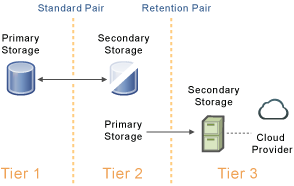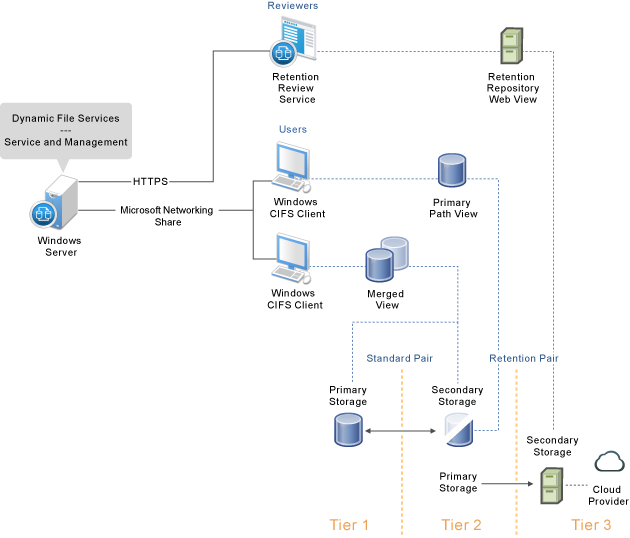1.1 Benefits of Dynamic File Services
Unstructured data is growing faster, consuming more space, and being retained longer than ever before. Novell Dynamic File Services enables you to manage your unstructured data with intelligent tiering in Microsoft Active Directory and Workgroup environments.
Dynamic File Services can help reduce storage infrastructure costs, save work hours, enhance existing investments in storage hardware and software, and improve retention compliance. Its many benefits are described in the following sections:
1.1.1 Store Data Efficiently by Tiering Data
A standard pair allows you to tier data between two storage locations. Users access a merged view of the files.
-
Frequently accessed data is stored on the primary path. Its high-performance storage system ensures that users remain productive. You can define policies to move data to the secondary path based on the date the file was last modified or accessed.
-
Store your mission-critical data on the primary path. Store less-important data on the secondary path. For example, if users store personal music files on the system, you can define policies that transparently move files based on their file extension or file type to the secondary location, where the cost to store the data is less. The file content can be scanned to ensure that file types are moved regardless of how a file is named.
-
Allocate files between the primary and secondary paths based on their file size. This allows you to distribute files between two disks to make the most of the storage capacity that you have. Large files that rarely or never change can be available to users without consuming expensive storage.
1.1.2 Offload Retention Data to Less Expensive Storage
A retention pair allows you to tier data between an active storage location and a retention repository. Users access only the files on the primary location. Reviewers can view retained data by using a Retention Review Service.
-
Store active data on the primary path that resides on your high-performance storage. Store files that do not change, but need to be retained for historical or legal reasons in a retention repository on the secondary path.
-
Create policies to relocate files to the retention repository based on the date it was last modified. You can further narrow the selection by applying other filters such as the file owner or file type.
1.1.3 Integrate Network Attached Storage with Ease
Dynamic File Services supports using remote paths in a pair, such as published shares on network attached storage (NAS).
-
Create a standard pair with a secondary path on a remote device such as a network filer. You can take advantage of lower-cost secondary storage solutions and seamlessly expand storage capacity without affecting users. Users see a merged view of the files.
-
Create a retention pair on the DynamicFS server that uses a primary path and secondary path on different remote network filers. You can move files into a retention repository while allowing users to access files on the primary path.
1.1.4 Store Retention Data in the Cloud
Dynamic File Services supports using a path on your cloud storage account as the secondary path in a retention pair. You set up credentials to authorize Dynamic File Services to access files stored there on your behalf. Supported cloud providers include Amazon Simple Storage Service (Amazon S3), CloudMe, and Dropbox.
1.1.5 Tier Data across Local Storage, Filers, and Cloud Storage
Pair tiering can be used to move data from local storage to filers to cloud storage at different stages of its life cycle. Dynamic File Services allows you to tier your storage solution by using the secondary path of a standard pair as the primary path of a retention pair, as shown in Figure 1-3. The standard pair and retention pair can reside on the same or different server.
For a tiered data solution, the first tier is the primary path of a standard pair. The second tier is the secondary path of the standard pair. The same share is also used as the primary path of a retention pair. The third tier is the secondary path of the retention pair. A tiered solution can use any combination of supported devices for the standard pair and retention pair.
Figure 1-3 illustrates the possible device types that you can use for your tiering solution.
Figure 1-3 Tiering Data with a Standard Pair and a Retention Pair

In Figure 1-4, the secondary path of the standard pair is a remote share on a network filer. The primary path of the retention pair uses the same path. The secondary path of the retention pair is a path on cloud storage.
Figure 1-4 Tiering Data with Local, Filer, and Cloud Storage

Figure 1-5 shows how users view the tiered data. Typically, all users access files via a share on the primary path of the standard pair. They see a merged view of the files on its primary and secondary path. The remote share used on the secondary path also serves as the primary path of the retention pair. Users accessing the remote share can see only the data on the secondary storage location. In a tiering configuration, you should prevent users from directly accessing the remote share. Users who are assigned as reviewers for the retention pair can use the Retention Review Service to determine whether to keep, permanently delete, or restore the data stored in the retention repository in the cloud.
Figure 1-5 User View of Tiered Pairs

As files on the first tier age, you can execute policies on the standard pair to move the older files to the second tier of storage on a network filer. When files in the second tier are rarely used, you can execute policies on the retention pair to move the files to a retention repository in cloud storage. Files moved from the second tier into the repository are no longer available to users via the merged view of the standard pair. The files in the retention repository are at the end of their life cycle. Reviewers determine how long files are retained in the repository.
1.1.6 Access Files in a Merged View Securely and Transparently
Dynamic File Services allows you to manage storage without impacting users.
-
Users can transparently access files on both paths of a standard pair via a network share on the primary path.
-
The native access control for the underlying file systems controls user access to the data.
-
In a merged file view, all access to the secondary path is made via DynamicFS as if the data were located on the primary path. DynamicFS does not need to relocate the data to give the user access to data on the secondary path.
-
Administrators can access the merged view of the data to configure user access to files and directories on both locations in a standard pair.
1.1.7 Review Retention Data to Keep, Purge, or Restore Files
-
A reviewer can be granted review rights on all retention pairs, or only on specified pairs.
-
Data in the repository is retained indefinitely. The Retention Review Service allows authorized reviewers to keep, purge, or restore retained files. Reviewers cannot read or modify a file’s contents.
-
A reviewers’ actions are guided by external constraints as defined in your company’s data retention policy. All actions taken during a review session are audited.
1.1.8 Move Data Seamlessly between the Two Paths
Dynamic File Services allows you to create policies that automatically move unstructured files between the two paths.
-
A single policy can move data in one direction: from the primary path to the secondary path, or from the secondary path to the primary path.
-
You can include paths or exclude paths for a pair’s primary path. Including folders allows you to apply policies only to some folders in a pair. Excluding folders allows you to apply policies to all folders except the excluded ones. The include or exclude setting applies to all policies for a pair.
-
Policy rules are based on the file size, last modified date, last accessed date, file name patterns, file type, and file owner (by user or group).
-
You can apply a policy to multiple pairs.
-
You can apply multiple policies to a pair.
-
You can define one-time moves of files or folders from the primary path to the secondary path.
-
You can use policies and one-time moves to help migrate data to new storage with minimal end-user impact.
1.1.9 Run Policies Whenever You Want
Policies allow you to control what type of files are moved and when they are moved.
-
Every policy runs independently and has its own schedule. A policy’s schedule applies to all pairs associated with it.
-
You can run a single policy at a time on a pair to enforce the policy’s rules for moving data. A file is moved if it meets all of the filter options specified in the rule.
-
You can configure multiple policies to run at the same time on a pair to enforce alternative rules for moving data. A file is moved if it satisfies the rules in any one of the concurrently scheduled policies.
-
You can schedule the window of time when you want a policy to run by specifying the start time and duration of the run.
-
You can schedule a policy to run hourly, daily, weekly, monthly, quarterly, yearly, or on custom dates.
-
You can start and stop policies manually. Scheduled and unscheduled policies can be run manually for one or more of their associated pairs.
1.1.10 Reduce Backup Time
By moving inactive or little used data to a secondary location, you reduce the time necessary to back up the system.
-
Less data needs to be scanned for the daily backup of the primary path.
-
You can back up the secondary path less frequently, without affecting user access to the data they use most often.